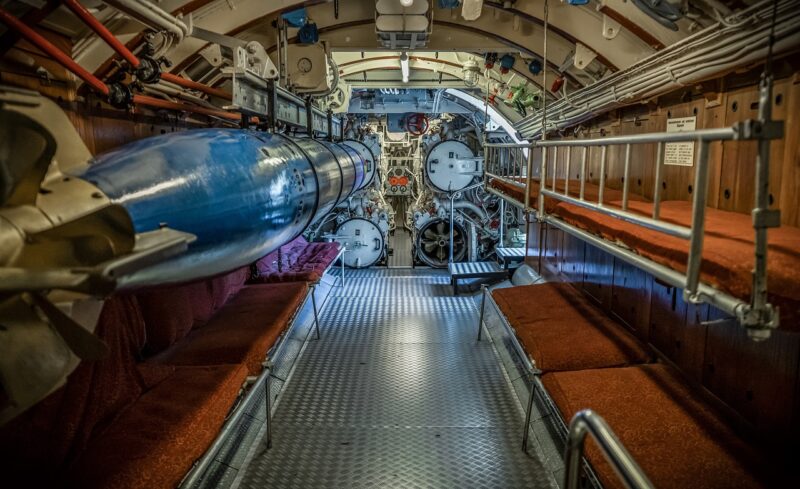
The history of warfare and exploration is filled with extraordinary inventions that altered the course of human events. Among these groundbreaking developments, the submarine stands out as a marvel of engineering that opened up a new frontier for naval warfare. But how did this remarkable vessel come to be? In this article, we’ll delve into the story behind the invention of the world’s first submarine, examining its origins, key figures, and the technological advancements that made it possible.
1. The Need for Underwater Exploration
The concept of submersible vessels has intrigued humanity for centuries. As early as the 4th century BC, the ancient Greek philosopher Archimedes theorized about the principles of buoyancy and displacement, ideas that would later be crucial for submarine design. However, it wasn’t until the 17th century that practical efforts were made to create a functioning submarine.
During times of conflict, the need for stealth and surprise would inspire inventors and military strategists to explore underwater capabilities. The burgeoning age of exploration, coupled with naval warfare’s demands, set the stage for the development of the first true submarine.
2. Early Designs: The Dive and Swim of the Submarine
In 1620, a Dutch inventor named Cornelius Drebbel designed and constructed the first operational submarine, aptly named the “Drebbel.” This remarkable vessel, resembling a modern-day rowboat, was made of wood and coated in greased leather, measuring about 13 feet in length. With oars protruding from its sides, it had the capacity for 12 men and could dive underwater to a depth of about 15 feet.
Drebbel’s submarine operated using a simplistic maneuvering system—large wooden oars powered by the crew. To achieve submersion, air was released from a series of buoyancy compartments positioned at the vessel’s sides, allowing it to sink. Drebbel’s submarine made several successful demonstrations in the River Thames before drawing the attention of King James I of England.
The vessel illuminated Drebbel’s vision of underwater warfare, and he even proposed its use in naval combat, stressing its advantages in surprise attacks. However, despite its innovative design, the Drebbel lacked the sustained underwater capability characteristic of modern submarines.
3. The American Revolution: An Emerging Tactical Innovation
Fast forward to the late 18th century, a period marked by the American Revolution. In 1776, an American inventor named David Bushnell constructed the “Turtle,” widely recognized as the first military submarine. The Turtle was a one-man vessel, entirely made of wood, skilled for stealth operations.
This small, egg-shaped submarine was designed for a mission targeting British warships in New York Harbor. Bushnell aimed to attach explosive charges to enemy vessels without being detected. The Turtle featured a hand-cranked screw propeller that allowed it to maneuver underwater, albeit limited.
Despite its ingenious design, the Turtle was unable to successfully execute its intended mission, as its diving capabilities and the operator’s physical strain proved challenging. Nevertheless, the Turtle marked an important step toward future submarine design and showcased the ongoing interest in submersible vehicles.
4. The Evolution of Submarines in the 19th Century
The 19th century saw significant advancements in submarine technology, driven largely by the naval arms race between major world powers. The introduction of steam power and iron-hulled vessels revolutionized submarine design.
In 1863, the American Civil War prompted the design of the “HL Hunley,” the first combat submarine to sink an enemy warship. The Hunley was a crewed, hand-powered ironclad that successfully sunk the USS Housatonic in 1864. However, the Hunley tragically sank resulting in the loss of its crew shortly after the attack.
This period saw numerous submarine concepts arise, showcasing varying designs that were often forgotten or lost, but with each attempt came new insights into hydrodynamics, buoyancy, and propulsion, bringing the world closer to the fully functional submarines we know today.
5. The Dawn of the Modern Submarine
It wasn’t until the turn of the 20th century that submarines as we know them truly began to emerge. The invention of the diesel engine, combined with advancements in electric battery technology, led to the first successful long-range submarines.
The German U-boats of World War I are perhaps the most famous submarines of this era, showcasing advanced technology and strategic capabilities. These vessels introduced torpedoes and the ability to stay submerged longer than any of their predecessors, marking a turning point in naval warfare.
By the early 20th century, submarines had transitioned from experimental vessels to core components of naval fleets worldwide, initiating a new era of underwater exploration and combat operation.
6. Conclusion: A Lasting Legacy
The invention of the submarine reflects humanity’s relentless quest for innovation. From the rudimentary designs of Drebbel and Bushnell to the powerful submarines used today, this vessel symbolizes the fusion of engineering and military strategy.
Submarines undeniably transformed the nature of warfare and exploration. Today, they serve numerous purposes, ranging from military applications to research and deep-sea exploration. The story of the submarine’s invention is but one chapter in the continuing narrative of human ingenuity and the pursuit of knowledge beneath the waves. As technological advancements continue to evolve, one can only imagine what the future holds for underwater exploration and the next generation of submarines.
If you’re intrigued by the history of innovations such as submarines, consider exploring the vast underwater world they operate in and the future developments poised to emerge in this domain.






